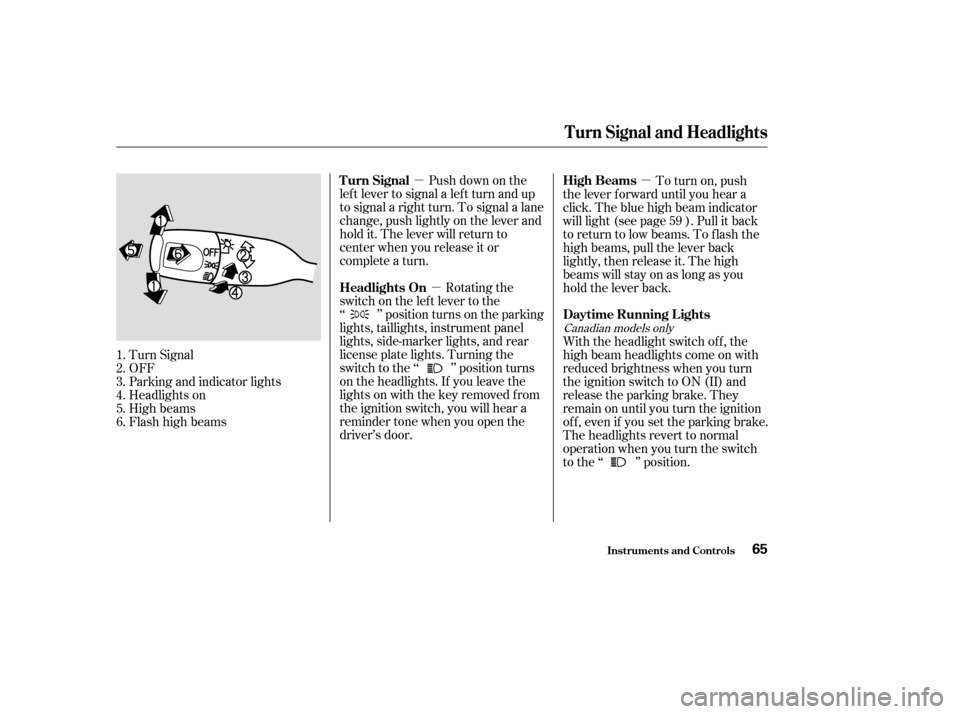Page 67 of 256
�Î
�Î
To use the horn, press the center pad of the steering wheel.
:
Controls Near the Steering Wheel
Inst rument s and Cont rols63
HEADLIGHTS/TURN SIGNALS
SHIFT LEVER (A/T)
CRUISE CONTROL MOONROOF
PARKING BRAKE
HORN
WINDSHIELD WIPERS/
WASHERS
A/T model is shown. REAR WINDOW DEFOGGER
(P.88)
(P.119) STEERING WHEEL ADJUSTMENT (P.67)(P.66)
(P.66) HAZARD WARNING BUTTON
(P.64) (P.141)
(P.65)
(P.68)
Page 69 of 256

�µ�µ �µ
Push down on the
lef t lever to signal a lef t turn and up
to signal a right turn. To signal a lane
change, push lightly on the lever and
hold it. The lever will return to
center when you release it or
complete a turn.
Rotating the
switch on the lef t lever to the
‘‘ ’’ position turns on the parking
lights, taillights, instrument panel
lights, side-marker lights, and rear
license plate lights. Turning the
switch to the ‘‘ ’’ position turns
on the headlights. If you leave the
lights on with the key removed f rom
the ignition switch, you will hear a
reminder tone when you open the
driver’s door. To turn on, push
the lever f orward until you hear a
click. The blue high beam indicator
will light (see page ). Pull it back
to return to low beams. To flash the
high beams, pull the lever back
lightly, then release it. The high
beams will stay on as long as you
hold the lever back.
With the headlight switch off, the
high beam headlights come on with
reduced brightness when you turn
the ignition switch to ON (II) and
release the parking brake. They
remain on until you turn the ignition
of f , even if you set the parking brake.
The headlights revert to normal
operation when you turn the switch
to the ‘‘ ’’ position.
Turn Signal
OFF
Parking and indicator lights
Headlights on
High beams
Flashhighbeams
1.
2.
3.
4.
5.
6. 59
Canadian models only
Turn Signal
Headlights On
High Beams
Daytime Running L ights
Inst rument s and Cont rols
Turn Signal and Headlights
65
Page 71 of 256
To release the parking brake, push
andholdthereleasebuttononthe
side of the parking brake lever, pull
the lever toward you slightly, then
push the lever f orward.
To apply the parking brake, f irmly
pull the parking brake lever toward
you.
Make sure the rear window is clear
and you have good visibility bef ore
starting to drive.
Thedefoggerwiresontheinsideof
the rear window can be accidentally
damaged. When cleaning the glass,
always wipe side-to-side.
The parking brake light on the
instrument panel should go out.
Parking Brake
Rear Window Def ogger, Parking Brake
Inst rument s and Cont rols67
NOTICE:
PARKING BRAKE
LEVER
RELEASE BUTTON
Driving the vehicle with the
parking brake applied can damage the
rear brakes and axles.
Page 88 of 256

Reverse this procedure to return the
seat to the upright position.
Make sure the seat is securely
latched bef ore driving.
When you are not using the
f astening strap, roll up the strap and
store it properly into the slit on the
seat-back.
Make sure all rear shoulder belts are
positioned in f ront of the rear seat-
backs.In the center seating position of the
rear seat, be sure the detachable
anchor is latched securely bef ore
using the seat belt (see page ).
Make sure all items in the cargo area
are secured. Loose items can f ly
f orward and cause injury if you have
to brake hard. See
on page .
The seat belt in the rear center seat
is equipped with a detachable anchor.
This allows the center seat belt to be
unlatched when the right side of the
rear seat is folded.
85
132 Carrying Cargo Detachable A nchor
Seats
Inst rument s and Cont rols84
Using a seat belt with the
detachable anchor unlatched
increases the chance of serious
injury or death in a crash.
Before using the seat belt,
make sure the detachable
anchor is correctly latched.
Page 99 of 256
Sitting on or getting under the table,
or putting heavy objects on the table,
may damage or deform it.
Do not put any items on the table
while driving. They may f all down or
f ly around when you go around
corners or brake hard.These sockets are intended to supply
power f or 12 volt DC accessories
that are rated 120 watts or less (10
amps).
When both sockets are being used,
the combined power rating of both
accessories should be 120 watts or
less (10 amps). To power an accessory, the ignition
switch must be in the ACCESSORY
(I) or ON (II) position.
These sockets will not power an
automotive type cigarette lighter
element. A ccessory Power Sockets
Center Table, A ccessory Power Sockets
Inst rument s and Cont rols95
Page 124 of 256

Cruise control may not hold the set
speed when you are going up and
down hills. If your speed increases
going down a hill, use the brakes to
slow down. This will cancel the
cruise control. To resume the set
speed, press the RESUME/accel
button. The CRUISE CONTROL
light on the instrument panel will
come back on.You can increase the set cruising
speed in any of these ways:
Press and hold the RESUME/
accel button. When you reach the
desired cruising speed, release the
button.
To increase your speed in very
small amounts, tap the RESUME/
accel button. Each time you do
this, your vehicle will speed up
about 1 mph (1.6 km/h).
Push on the accelerator pedal.
Accelerate to the desired cruising
speed and press the SET/decel
button. You can decrease the set cruising
speed in any of these ways:
Press and hold the SET/decel
button. Release the button when
you reach the desired speed.
To slow down in very small
amounts, tap the SET/decel
button. Each time you do this,
your vehicle will slow down about
1 mph (1.6 km/h).
Tap the brake or clutch pedal
lightly with your f oot. The
CRUISE CONTROL light on the
instrument panel will go out.
When the vehicle slows to the
desired speed, press the SET/
decel button.
Changing the Set Speed
Cruise Control
Comf ort and Convenience Feat ures120
Page 125 of 256

Even with the cruise control turned
on, you can still use the accelerator
pedal to speed up f or passing. Af ter
completing the pass, take your foot
of f the accelerator pedal. The vehicle
will return to the set cruising speed.
Resting your f oot on the brake or
clutch pedal will cause the cruise
control to cancel.Youcancancelthecruisecontrolin
any of these ways:
Tap the brake or clutch pedal.
Push the CANCEL button on the
steering wheel.
Press the Cruise Control Master
Switch. When you push the CANCEL button,
or tap the brake or clutch pedal, the
system remembers the previously-
set cruising speed. To return to that
speed, accelerate to above 25 mph
(40 km/h) and then press and
release the RESUME/accel button.
The CRUISE CONTROL light comes
on. The vehicle will accelerate to the
same cruising speed as bef ore.
Pressing the Cruise Control Master
Switch turns the system of f and
erases the previous cruising speed.
Cancelling the Cruise Control Resuming the Set Speed
Cruise Control
Comf ort and Convenience Feat ures121
Page 128 of 256

Help assure your vehicle’s f uture
reliability and perf ormance by paying
extra attention to how you drive
during the f irst 600 miles (1,000 km).Avoid full throttle starts and rapid
acceleration.
Do not change the oil until the
scheduled maintenance time.
Avoidhardbrakingforthefirst
200 miles (300 km).
During this period:
Your Honda is designed to operate
on unleaded gasoline with a pump
octane number of 86 or higher. Use
of a lower octane gasoline can cause
a persistent, heavy, metallic rapping
noise in the engine that can lead to
mechanical f ailure.
We recommend using a gasoline
containing detergent additives that
help prevent f uel system and engine
deposits.
In addition, in order to maintain good
perf ormance, f uel economy, and
emissions control, we strongly
recommend, in areas where it is
available, the use of gasoline that
does NOT contain manganese-based
f uel additives such as MMT.
Use of gasoline with these additives
may adversely af f ect perf ormance,
and cause the Malfunction Indicator
Lamp on your instrument panel to
come on. If this happens, contactyour authorized Honda dealer f or
service.
For f urther important f uel-related
inf ormation, please ref er to your
Quick Start Guide.
You should also f ollow these re-
commendations with an overhauled
or exchanged engine, or when the
brakes are replaced. Do not tow a trailer. Some gasoline today is blended with
oxygenates such as ethanol or
MTBE. Your vehicle is designed to
operate on oxygenated gasoline
containing up to 10 percent ethanol
by volume and up to 15 percent
MTBE by volume. Do not use
gasoline containing methanol.
Bef ore Driving
Break-in Period
Gasoline Type
Break-in Period, Gasoline T ype
124